(a history and astronomy research)
|
|
“Before referring to materials on Göbekli Tepe, we need to understand we deal here with a rather advanced culture maintained by our ancestors in the 10th millennium BC.” Klaus Schmidt. Sie bauten die ersten Tempel. Das rätselhafte Heiligtum der Steinzeitjäger |
Göbekli Tepe (“Potbelly Hill” in Turkish) is a temple complex located on the Armenian Plateau in upper reaches of Euphrates, 8 kilometres away from present-day Şanlıurfa (the city which in antique times was called by the Greek name Edessa), in the south-eastern part of Turkey. As of today, it is the oldest megalithic structure in the world.
|
Geographic location. |
Upper reaches of Tigris and Euphrates. |
The Turkish word Göbek means “navel”, “belly”, “potbelly”, or “cupola”. The best translation for Göbekli Tepe is “the Navel of the Earth” or “the Prominent Mount” – the name that accurately reflects the hill’s silhouette. It rises as a huge cupola above the flat limestone plateau. Yet, should we look at it closer we can see Göbekli Tepe contours are quite blurred, since it represents a hilly landscape in miniature, with many peaks and depressions. It has turned out these depressions have accumulated heavy Layer I deposits.
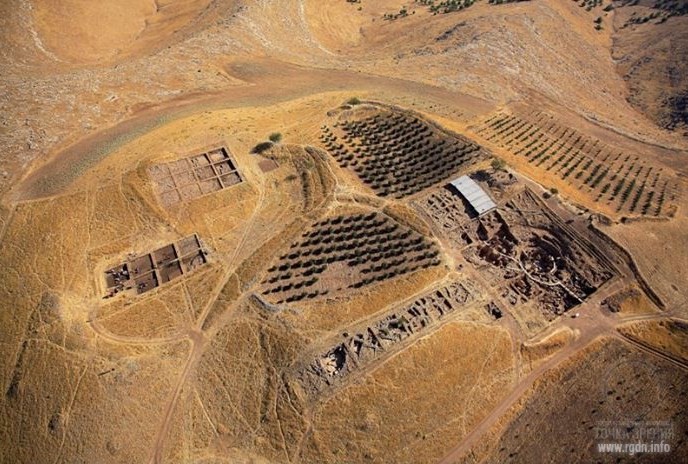
Göbekli Tepe bird's-eye view

Satellite view of the plateau
For the first time archaeologists came to these lands in the early 1960s. Having examined the area, American researchers assumed there were remains of a Byzantine cemetery. A relevant note was published in a specialised journal, but caused no special interest of scientific circles. Thus, Göbekli Tepe was forgotten for a certain while before one occurrence.
Once local farmers, while clearing from stones a plot adjoining the hill foot, discovered masonry. Blocks were close to the land surface and prevented the farmers from ploughing. When they started extracting the blocks, they discovered high reliefs on many of them. Such finds were not the first ones for the farmers, but previously they had simply put them on the hill slopes together with other stones. Nonetheless, the news reached employees of the ArchaeologyMuseum of Şanlıurfa.
|
Klaus Schmidt |
In order to check the information obtained from the museum, in 1994 Klaus Schmidt, an archaeologist from Berlin, arrived to the site along with his old university friend Michael Morsch. After detailed examination of the hill slopes the archaeologists discovered numerous silicon cleavages which abundantly covered the hill. The artefacts were obviously man-made, though no splinters of ceramics were found around. On one of remote elevations on the hill there was a real surprise for the researchers: several fragments of T-shaped pillars looked out of the ground. |
That was the last evidence that the hill was of artificial origin and concealed a monument of the early pre-ceramic Stone Age, a monument of incredibly big dimensions. It became obvious an expedition was to be arranged.
Thus, only in 1995 excavations started at the site with the involvement of employees of Istanbul Department of Deutsche Archäologische Institut (DAI) in cooperation with the ArchaeologyMuseum of Şanlıurfa, and the excavations were headed by Klaus Schmidt. The study of this monument became the affair of Schmidt’s life, whereas the aforesaid occurrence went down in history as the second discovery of Göbekli Tepe (GT).
At the end of the first research campaign there remained no doubts that we had discovered a cult site developed by people of the entire region for a long time, and the cult site had been possibly attended even much earlier for certain religious actions.
(Klaus Schmidt. Sie bauten die ersten Tempel. Das rätselhafte Heiligtum der Steinzeitjäger)
Archaeological excavations are a hard work requiring general management, planning, relevant skills, time, as well as financial and human resources. Furthermore, field works in this region are possible only during several months in spring and autumn, since it is extremely hot here in summer and too windy in winter.
|
The south-eastern slope of the hill (view of the excavations)
A wolf
A wild boar Some finds of the first days of excavations |
Having limited resources at his disposal, Schmidt decided to begin excavations on the south-eastern slope of the hill, right at the spot where the farmers had left a deep pit when they had extracted the stone blocks from the ground. Once the archaeologists started their works, their preliminary estimations of the site age were totally confirmed. Starting straight from the ground surface and down into the depth, the archaeologists discovered not less than five cultural layers. They excavated stone walls, vertically standing massive stone pillars (orthostats), remains of four layers of mosaic floors laid on each other, and numerous stones with diverse animal images. |
According to radiocarbon dating, early layers of the monument date back to the 12th millennium BC. Hence, initial assumptions of archaeologists on the purpose of the monument were as follows: Göbekli Tepe was a cult site of hunting tribes that inhabited the region. Those could be exactly hunters because there was no farming in that age, while numerous animal and human images on local artefacts could signify hunting scenes. Based on ethnographic data, frequently found solitary or paired animal images, e.g. a bull, a wolf or a wild boar, were interpreted as probable tribal totems. Massive Т-shaped orthostats could serve as roof supports, since they were installed in pairs and in the centre of the “room”.
|
One of the circles (topside view) |
Artistic reconstruction |
|
Т-shaped pillar in the quarry
Artistic reconstruction |
It should be noted that some orthostats made of limestone weighed about 20 tons. A giant T-shaped pillar was found on the northern plateau among workpieces that remained in the quarry, not processed and not separated from the foundation. It is the largest of all known local architectural objects of the early Neolithic. The pillar has a residual length of about 7 m and a top width of 3 m. It weighs nearly 50 tons! Experts estimate that in order to move such a structure to the place where it was supposed to be installed the efforts of 400 to 600 people would have been required. At that, a needed number of able-bodied male population was hardy available in this locality, and no settlements of that age have been found around until now. Most probably, builders gathered from the entire region when necessary. Yet, what were such titanic efforts needed for?
|
Be it as it may, this complex of structures (circles) could have emerged only if the place itself and the actions on it were extremely important for all the participants, taking into account the enormous efforts taken by the builders.
Beyond all doubt, these symbols were visual means intended to transfer into the remote future themes and scenes essential for the culture of those who created them, otherwise people would not have invested so much time and effort into presentation of the symbols in such a way in a complex of monumental cult structures that capture one’s imagination.
(Klaus Schmidt. Sie bauten die ersten Tempel. Das rätselhafte Heiligtum der Steinzeitjäger)
As the excavations proceeded, the previous hunting hypothesis had further fewer supporters.
In subsequent sections of the monument archaeologists discovered orthostats with complex scenes depicted on them, which could hardly be regarded as hunting scenes. Along with other animals, many scenes contained images of snakes, spiders, scorpions and diverse birds, placed in a certain sequence, one by one or in groups. Furthermore, in central sections of some pillars abstract signs and symbols were carved – Н-shaped ones in various forms of presentation, as well as a crescent with a circle above.
|
Circle D, Pillar 33 |
Circle D, Pillar 33 (side view) |
|
Abstract signs and symbols on pillars |
One “room” was cleared, including a five-stepped stairway leading inside and a table-high plate made of rock, most probably having an altar purpose. Archaeologists also discovered several stone portals, supposedly intended to separate the sacral space of the temple from the outside world.
Stone portal with snakes |
|
Stone portal: Circle B |
Stone portal: Circle В (overall view) |
|
Fox image on the pillar side |
There were numerous full-scale images of foxes, mostly in aggressive poses. Fox images were carved on pillars and sides of central T-shaped orthostats. Yet, why is this image so widespread on GT artefacts? It is difficult to call a fox a totem. This question still lacks an intelligible answer on the part of experts, and we will recur to it later herein.
|
In addition to fox images, some Т-shaped orthostats contained images of human hands and torsos. These nuances enabled researchers to assert that:
Göbekli Tepe pillars should be understood as stone images of human beings.
Hence, there came understanding that:
The pillars were not structural elements of a building, but a whole heart of it, whereas the building itself served as a mere frame for such a centre.
|
Circle D. Pillar 18 |
Scheme of the human-like pillar |
Archaeologists carefully recorded on paper all scenes depicted on Göbekli Tepe pillars, endeavouring to grasp the meaning of the images. Then they suggested their interpretations based on extant historical sources. Here is an example of such interpretation from Klaus Schmidt’s Sie bauten die ersten Tempel… :
|
Circle А. Pillar 1 |
“… beyond any doubt, the net on Pillar 1 may be interpreted as a net made of snakes or a gathering of snakes… Quite possibly, the serpentine net and the sheep on Pillar 1 illustrate a ritual transferred to us from a Hittite source in the 2nd millennium BC. Hence, we should assume that Hittites knew the ritual content. It is a so-called scapegoat motif: during the ritual all sins and vices are “shifted” onto a goat, and at the end of such procedure the animal is driven out into the desert, being left to its own destiny. Thus, evil forces are driven away from the human community. These actions point at the origin and function of a scapegoat motif still applied nowadays. … As for the anthropomorphic creature depicted on Pillar 1, in view of all the aforesaid it may be regarded as a person who performed such ritual.” .
|
It is noteworthy that numerous animals on the pillars are mostly depicted in aggressive poses and look inside the circle. On paired pillars animals are depicted on corresponding sides of orthostats directed towards their double and look towards the entrance. Archaeologists assume these figures were installed for apotropaic purposes, i.e. their task was to prevent or rather scare away troubles. They could have possibly guarded something as well, e.g. like Cerberus dog in antique mythology guarded the entrance to the underworld – the kingdom of the dead. The animal figures are assisted by numerous snakes that creep along the pillars, almost always down, towards the observer.
|
A bird carrying a head in its claws |
Numerous images of headless people and separate human heads, which are made of stone and carried in bird or animal claws, as well as the lack of female symbols habitual for Neolithic settlements in that region and signifying fertility and life as such, provided archaeologists with grounds to interpret the monument as a site intended for rituals dedicated to the deceased.
|
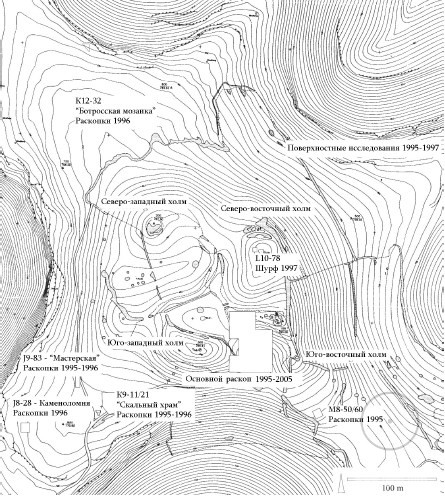
Topographic scheme of the archaeological site
.
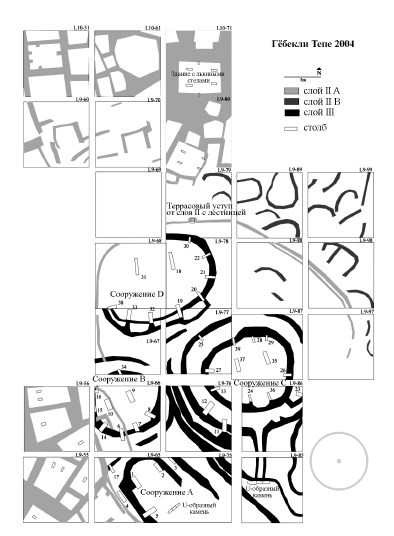
Layout of the archaeological site
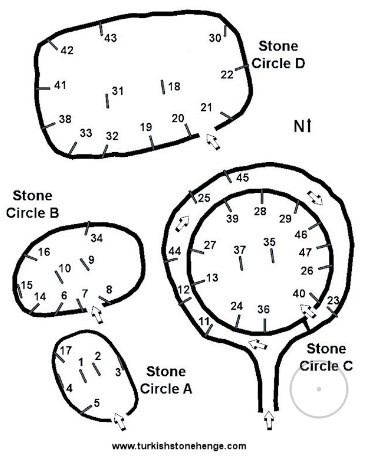
Scheme of the excavated structures
People’s thoughts were far from being totally dedicated to vital issues of their everyday existence, but were further more directed towards complex issues of the structure of the universe and reflected the reality via mythic images.
(Klaus Schmidt. Sie bauten die ersten Tempel. Das rätselhafte Heiligtum der Steinzeitjäger)
A new discipline has recently emerged and gains further greater popularity. It is archaeoastronomy – a combination of archaeology and astronomy. Unfortunately, most mainstream historians treat this discipline sceptically, thus so far it remains a field for true enthusiasts. The latter don’t limit themselves to archaeology only, but on the contrary boldly analyse and compare facts from a number of diverse mutually complementary disciplines, such as geology, climatology, physics, and astronomy. As a result, new interesting hypotheses appear, which surely contain a core of good sense, but are rigidly criticized by representatives of mainstream science. It is worth considering some of them.
|
Göbekli Tepe hypothetical model
A limestone ring. |
So, as of today it is known that GT complex consists of several circles of structures, positioned in a certain order relative to each other. By means of field magnetic photography it has been ascertained there are about 20 of such circles, however only 4 of them have been excavated until today. By the sequence of discovery they are called Circles А, В, С and D. Researchers came up with a number of questions. If GT is a temple complex, why are there so many structures? At that, why do central pillars in different circles have different orientations to the cardinal points? In quest of answers to these questions, some researchers came to a conclusion that GT is not a mere temple, but first and foremost an observatory. Such assumption is supported by local artefacts, e.g. limestone rings often found at the site during the excavations. Such rings have been discovered in GT only, and since there are no analogues of them elsewhere in the world archaeologists cannot grasp their purpose so far. Yet, it is quite possible to use these rings as a tool to observe the stellar sky! Probably, the same purpose was of apertures carved in some pillars, as well as of hollows in polished limestone plates. |
|
Hollows in a limestone plate. |
Apertures carved in pillars .
|
Several years ago, professor of Politecnico of Milan Giulio Magli, based on the analysis of cartographic data, satellite images, archaeological and other data, suggested a hypothesis that GT complex was dedicated to Sirius and intended for observations of the southern hemisphere sky. Why does he refer to this very star? While modelling the stellar sky for the 10th millennium BC by means of specialised software, Magli has discovered that a spectacular event took place above GT in that age – “the birth of a nova star” which we now call Sirius and which became the 4th brightest object in the night sky after Moon, Venus and Jupiter. It was certainly a very impressive spectacle for people of that time. Moreover, it is known that Sirius was worshipped by some ancient peoples. For instance, Egyptians identified Sirius (Sotis) with goddess Isis, while her husband Osiris was identified with the constellation of Orion (Sakh) – “the king of stars”. Furthermore, in the ancient Egyptian calendar every year began with the heliacal rising of Sirius. The Dogon tribe in Africa also maintained the cycle of their holidays with orientation at Sirius.
As for GT orientation, Magli’s observations are quite reasonable, since as currently known the excavated monumental structures of Layer III are located in a deep cavity that divides the southern slope into two halves and opens towards the valley. It is further true that due to precession it was impossible to observe Sirius in GT latitude for a long time – it moved beyond the horizon as long ago as circa 15,000 BC. Having reached its minimal height, the star began to approach the horizon and became visible again several days before the summer solstice circa 9300 BC.
|
Sirius in ascension |
Later on professor Magli discovered that the extrapolated average azimuths of Circles D, C and В (taken as mean lines between the two central monoliths) correspond to the rise azimuths of Sirius on the following approximate dates:
In other words, on the summer solstice days of these years Sirius was situated accurately at the horizon between the two central orthostats of each of the said circles.
|
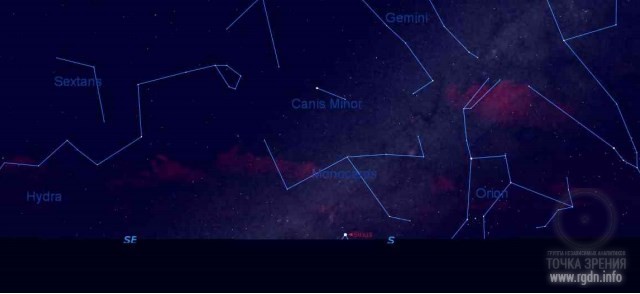
Ascension of Sirius (azimuth 172°) several days before the summer solstice in 9100 BC
At the end of his report professor Magli concludes this information should be treated as a scientific hypothesis only, because many points are still to be clarified. Moreover, it is necessary to take more accurate measurements right at the site by means of special equipment.
British writer and journalist Graham Hancock agrees with professor Magli. However, based on the data provided by the famous researcher of pyramids, Doctor of Geology, professor of Boston University Robert M. Schoch, Hancock suggested an assumption that GT could have been used for observations of the Orion constellation, too.
|
Scheme of orientation of central pillars. |
Another British writer and researcher of antiquities Andrew Collins criticises the aforesaid hypotheses. He points to the fact that the hill is man-made, thus most probably the complex was initially built on the flat valley rather than on the hill slope. Therefore, the northern sky could have been observed as well. Collins further indicates that central orthostats of the four excavated circles are oriented to the south, i.e. face the entrance. Therefore, one who enters the complex looks towards the north. Collins believes this may evidence that exactly the northern sky was observed. Moreover, so far the orientation of other 16 circles is unknown since they are not excavated. |
These are major hypotheses on the purpose of the temple complex. They contain certain discrepancies, but also a common grain: all researchers agree the complex is oriented by the stars, just like many other ancient structures. Hence, ancient inhabitants of that region obviously possessed relevant knowledge not only in construction, but in astronomy as well! Furthermore, they probably recorded their observations in some way habitual for that time – by carving certain images on temple pillars. In this regard, an extremely interesting question has been given no moment of rest to researchers lately: what message is encrypted on Pillar 43, or the Vulture Stone as it is otherwise called?
The people of Göbekli Tepe considered it important to record the Earth’s precession over very long timescales in a very visible and enduring fashion.
(Decoding Göbekli Tepe with Archaeoastronomy. What Does the Fox Say?)
In April 2017, Mediterranean Archaeology and Archaeometry published a report by two researchers of the University of Edinburgh – Martin B. Sweatman and Dimitrios Tsikritsis, under the title Decoding Göbekli Tepe with Archaeoastronomy. What Does the Fox Say? The report is freely available on the internet, so I won’t retell its contents in detail. Let’s just focus on the conclusions made by the authors after they had analysed all archaeology, geology and astronomy sources available on the subject, and let’s have a closer look at Pillar 43 which is of special interest for us.
So, the aforesaid researchers have come to the conclusion that this complex served as an observatory oriented by the north-south axis, and:
…a key function of Göbekli Tepe was to observe meteor showers and record cometary encounters. Indeed, the people of Göbekli Tepe appear to have had a special interest in the Taurid meteor stream, the same meteor stream that is proposed as responsible for the Younger Dryas event.
In geology the Younger Dryas is dated to 10,730 – 9700 ± 99 years BC. In recent years there have appeared incontrovertible facts that the drastic temperature fall which took place in the history of our planet at the end of the last ice age and lasted for about a thousand years was caused by a fall of a meteorite (or several meteorites) on the Earth’s northern hemisphere. This topic is considered in an extensive article published on our website and entitled The ruin of the Clovis culture and the riddle of the Younger Dryas.
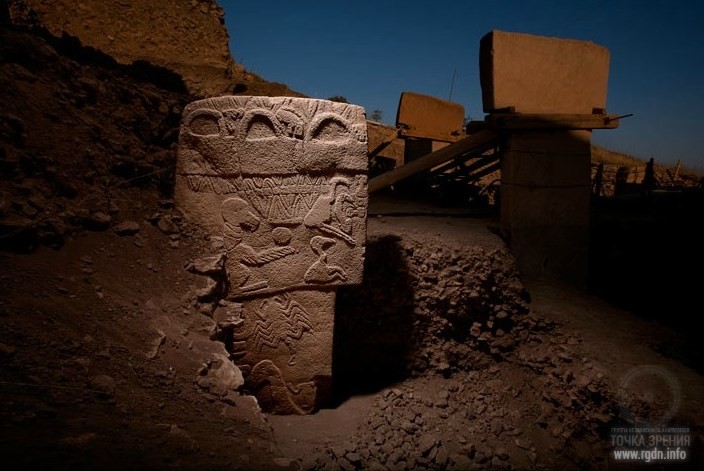
Circle D. Pillar 43 or the Vulture Stone
Now, let’s go back to Pillar 43. Sweatman and Tsikritsis interpret images on this pillar as celestial constellations positioned in a certain order. In their opinion, major symbols here are a scorpion that corresponds to the Scorpius constellation and an eagle / vulture that corresponds to the constellation of Sagittarius. A circle above the eagle’s / vulture’s wing corresponds to the Sun. In astronomy it is assumed that a zodiacal age is determined by the position of the Sun in a certain zodiacal sign at sunrise / sunset on one of the four favourable days during a year – vernal equinox, summer solstice, autumnal equinox or winter solstice. This is symbolised by peculiar “handbags” in the upper section of the Vulture Stone, which are interpreted as graphic representation of sunset or sunrise. By means of Stellarium software used for stellar sky modelling, the report authors carried out certain estimations and arrived at several probable dates:
The boldfaced date absolutely corresponds to GT archaeology. According to K. Schmidt, as of 2010 the earliest determinable date for organic contents of the plaster on some walls in Circle D corresponds to the unbelievable term of 11,530 BC ± 220 years! Let me also draw readers’ attention to the upper date of 21 December 2012 to which we will go back a little later.
Thus, the researchers have come to the conclusion that Pillar 43 is a sort of stone chronicle or “date seal”. That is, it carries a record of an event, a symbolical record of the date that correlates with location of the stars when the aforesaid cataclysm took place, i.e. in 10,950 BC ± 250 years. This date precisely corresponds to the beginning of the Younger Dryas. At that, in the opinion of the report authors, the headless human figure in the lower right section of the pillar shows the cataclysm was fatal for the majority of earthly population. It is noteworthy that such statement is criticised by archaeologists of the Göbekli Tepe Research Staff who say the human figure has an erect phallus, which contradicts the destruction hypothesis.
In his book The Human Genetic Code Russian researcher Andrew Sklyarov writes that traces of a powerful tsunami caused by the aforesaid cataclysm may be found even today:
Ollantaytambo complex has preserved traces of destruction by a powerful water flow in Urubamba valley, which flow was against the river stream and was an “echo” of the Flood tsunami from the Pacific Ocean. The pyramid in Mexican Cholula is covered with a heavy clay cap of mud sediments. Similar sediments have been found in Teotihuacan (Mexico) and Göbekli Tepe (Turkey).
Most probably, it was “the end of times” of the previous earthly civilization of Atlantes. Thereafter everything started anew…
It should be mentioned that some statements in the report, e.g. the interpretation regarding Pillar 43, were already heard earlier. Graham Hancock wrote about this in his book Magicians of the Gods. Later on Andrew Collins, in response to Hancock’s book, criticised the hypothesis and suggested an alternative interpretation. Thus, he asserts it is wrong to correlate the eagle / vulture image with the constellation of Sagittarius because since ancient times a vulture was usually associated with other constellations:
In Hellenic mythology such heavenly bird images were interpreted as the three Stymphalian birds that attacked Heracles. Moreover, all three constellations are in the same region of the sky, and their bright stars Deneb, Vega and Altair are known as the Summer Triangle.
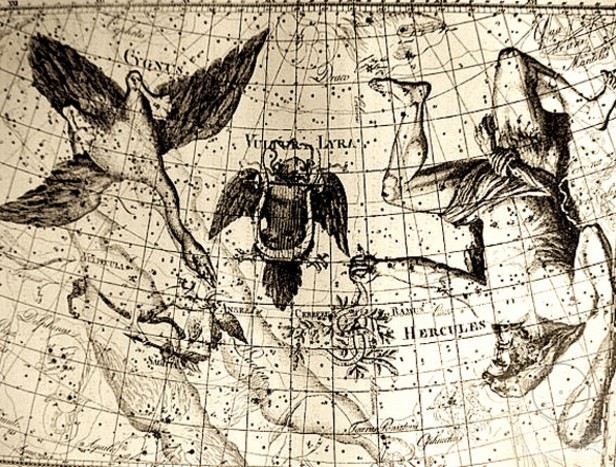
Star chart with locations of the constellations of Cygnus, Lyra and Hercules. The Aquila constellation is located below this section of the chart.
|
“Vulture” location relative to locations of the constellations. |
Collins eventually concludes that, if the vulture on Pillar 43 indeed represents one of the three heavenly birds, it should most probably embody the constellation of Cygnus. Besides, in his opinion, the two central pillars in Circle D when it was constructed (as well as in Circles B, C and E) were precisely pointed at Deneb – the brightest star of the Cygnus constellation. He further adds that the shape of the vulture’s wings on Pillar 43 almost accurately reflects the scheme of major stars in Cygnus in 9400 BC, whereas the latter is an estimated date of Circle D construction. |
There is a drawback in Collins’s orderly line of reflections however. The thing is that, according to archaeological data, Circle D is dated to the earlier period as has been mentioned above.
Yet, let us recur to what Graham Hancock wrote. After all, he pointed to a very interesting peculiarity. Let me refer to an extract from his book:
Complex zodiacal signs are inscribed on one of its limestone pillars, incorporating astronomical data supposedly not discovered until thousands of years later. Even more puzzling is the position of the stars – not quite where they would have been in the sky 12,000 years ago... but exactly where they are today.
It is as though these mysterious, impossibly learned builders constructed their temple as though it existed in the present day.
Hence, Hancock believes Göbekli Tepe is a time capsule, a sort of message to the future, and it is no mere chance that the site was buried and closed down, having turned into an unremarkable sandy hill, just one among many others, as long ago as in the 8th millennium BC. At that, based on the stars, the time when the message was to be revealed is nowadays, and this is exactly what happened!
Hancock provides his version of decryption of the said message. He believes the ancient builders forewarned the humanity of our time that between 1960 and 2040 AD another global disaster is in store for the earthlings. Within this 80-year timeframe the comet that caused the beginning of the Younger Dryas (or fragments of such comet) may imperil the world again. His conclusions are far from being unsubstantiated, and we already touched upon this subject in relevant articles. One of them is The revealed secrets of Angkor and Giza plateau – the pendulum of Orion and Draco. Apocalypse now?
Yet, which exactly message is encrypted on Pillar 43? We’ve decided to look at the stars with the help of Stellarium and conduct our own analysis, but before we proceed to it let’s draw some conclusions:
Quite possibly, it was to communicate to potentially sceptical generations that followed that a great truth about the ordering of the world was known, and that this truth was important for their continued prosperity, and perhaps survival.
(Decoding Göbekli Tepe with Archaeoastronomy. What Does the Fox Say?)
To begin with, let’s look at Pillar 43 and draw certain comparisons with the constellations.
|
Pillar 43, or the Vulture Stone. Circle D |
Image of the Scorpius constellation |
|
|
Image of the Aquila constellation |
Image of the Orion constellation: the vertical Н-shaped symbol signifies the constellation, while the horizontal H-shaped symbol signifies Orion’s Belt. |
|
Everything is quite clear with Scorpius. As for the constellation of Aquila, it should be noted that the name of its brightest star Altair originates from the Arabic al-ta’ir meaning “the flying eagle or vulture”. Ptolemy called it Aetus – a Latin name for an eagle. Sumerians and Babylonians called it in a similar way, too.
Next is the Н-shaped symbol found not only on Pillar 43, but also on other pillars in different versions – vertical or horizontal, like on the Vulture Stone. Most probably, it signifies the Orion constellation. A horizontal version of the symbol (letter Н) indicates the three central stars of the constellation, the so-called Orion’s Belt. Now, in order to see the disposition of these constellations relative to each other, let’s look at the star chart below (for better understanding it is presented from two perspectives).
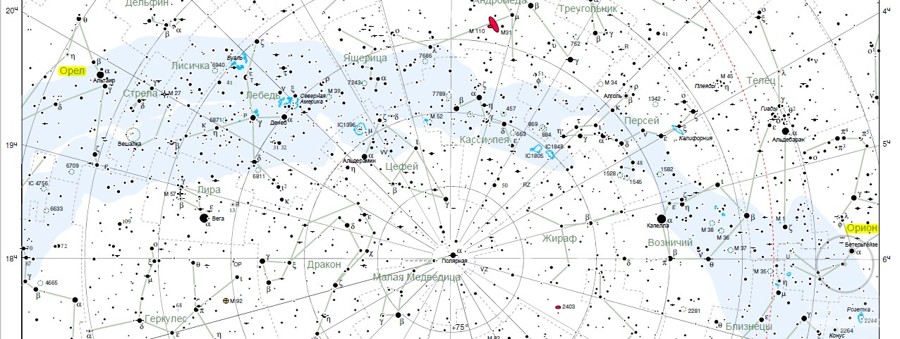
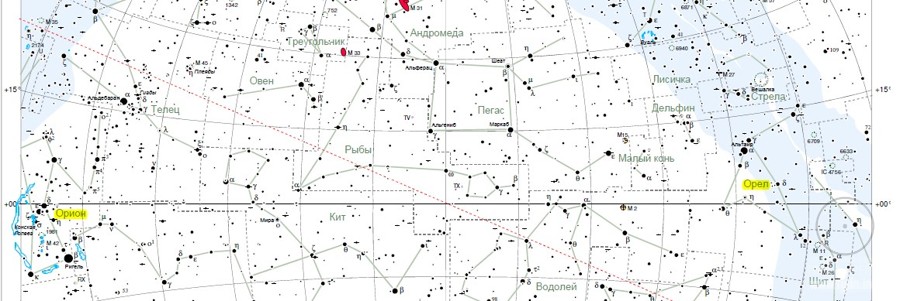
As we can see, both constellations are equatorial; therefore they are located almost on the same line, just like on Pillar 43. Why was it so important for ancient astronomers to depict Orion on this chronicle? Let’s recur to this question later.
Now, let’s see how the major constellations are located relative to each other.
|
Location of the Aquila constellation relative to Scorpius (nowadays) |
This star chart of the northern hemisphere sky clearly shows that the disposition of Aquila and Scorpius in summer and in autumn precisely corresponds to the image on the pillar. The chart also depicts the constellations of Sagittarius and Cygnus referred to in the previous section. Once we have compared major figures and symbols, let’s look at the sky of that age by means of Stellarium software, check our assumptions and draw parallels with our times.
|
Below, there are two images that point at 11 September 10,950 BC. In other words, this date is indicative of the time when the Sun, while moving along the ecliptic, crossed the line of the galactic equator. The two conventional lines cross in two points twice a year, since two non-coincident circles on a sphere cross in two points. One of such points is exactly shown here.
Moreover, the 11th of September was the summer solstice day 13,000 years ago. On the summer solstice the Sun culminates in its highest point at 84.4 degrees. The value is indicated for 31 degrees north.
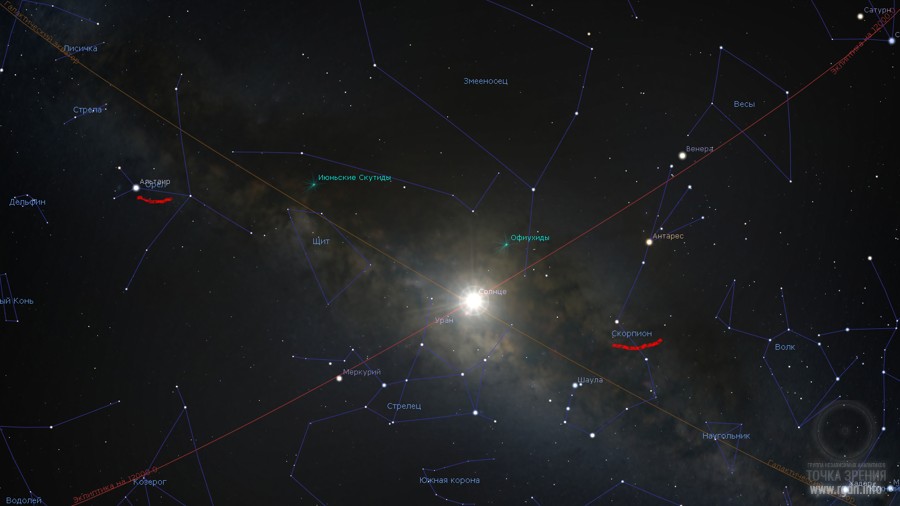
Another thing is that in the first picture we can see the Lupus (Wolf) constellation below Scorpius (on the right). On the Vulture Stone beside the scorpion there is a wolf image as well, partially covered under masonry.
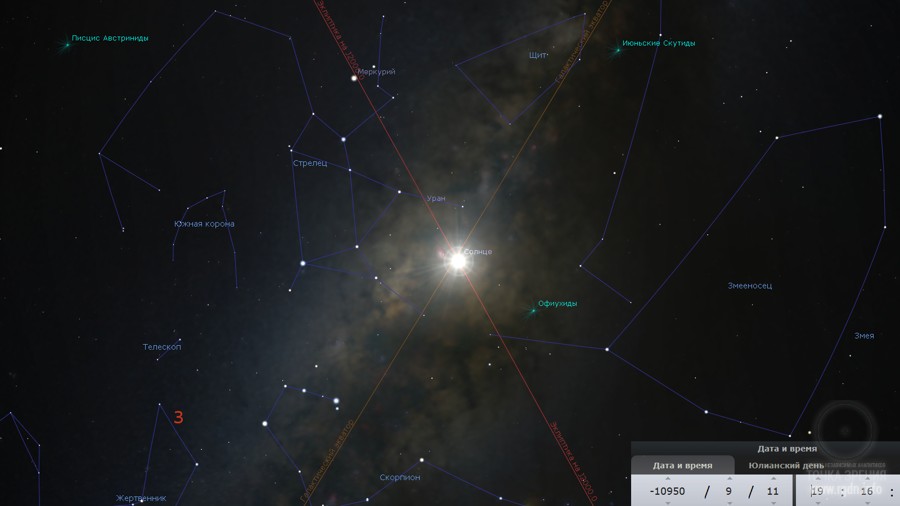
Now, let’s look at our times and the date of 21 December 2012 – the winter solstice day.
.
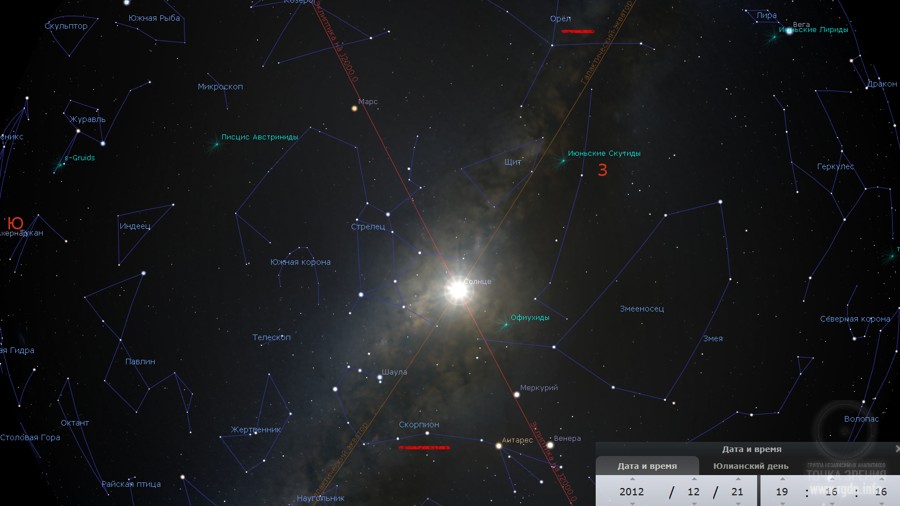
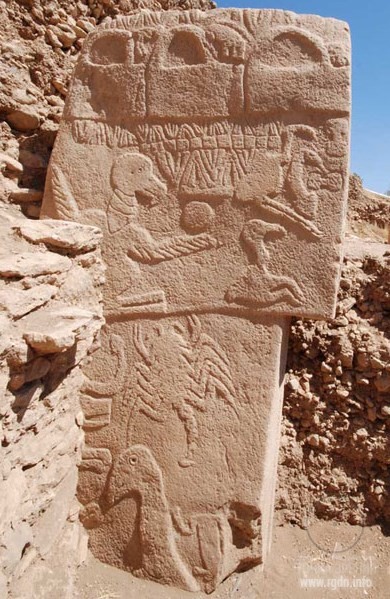 |
Recurring to Pillar 43, we can see a circle depicted above the vulture’s wing. Let us look at the sky.
|
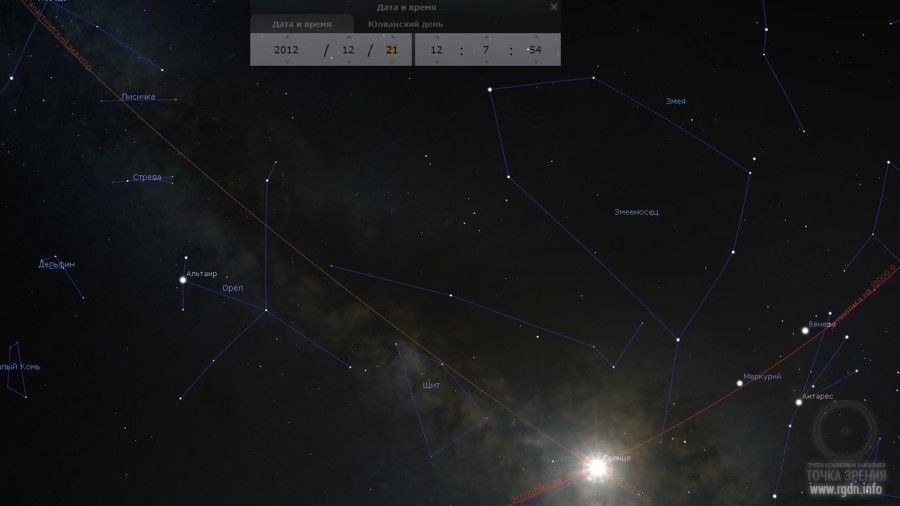
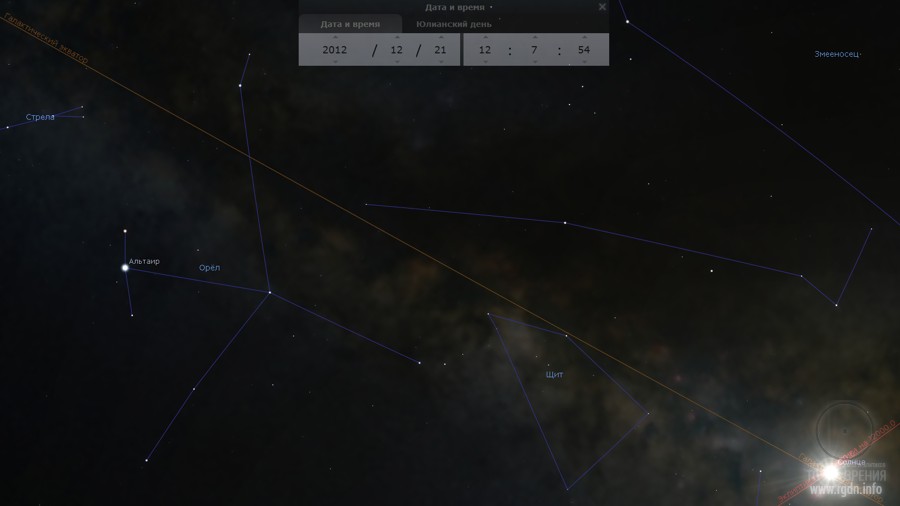
We can see the galactic equator running through the Eagle’s wing. Hence, the circle above the vulture’s wing on Pillar 43 means the Sun. It moves along the ecliptic line, while its image above the vulture’s wing signifies a point when the Sun crosses the galactic equator. As it has been shown above, nowadays it is the date of 21 December 2012.
The last element we haven’t yet considered on the Vulture Stone is peculiar marks located in the upper section of the pillar, which Hancock jokingly called “handbags”. There is a video with information on such “handbags” in the article Bearded God. Who is He? on our website. Among other things it shows the Vulture Stone. In mythology of various peoples of the world such “handbags” were depicted in the hands of Gods who gave Knowledge to humanity. Hence, the “handbags” symbolise the process of Knowledge introduction or transfer.
|
Sumerian deity |
Quetzalcoatl: a deity of the Aztecs and dwellers of Central America |
|
|
Oannes. Assyria |
Stone “handbags” in various cultures |
|
Thus, 11 September 10,950 BC was most probably a very important date for people of that time, just like 21 December 2012 is important nowadays, since on the latter day the Primordial Knowledge about the spiritual nature of humanity was given to the world again on the brink of ordeals to help people make their choice.
Hence, we have again recurred to the Orion-Draco pendulum, the cycle of which makes up 13,000 years and which indicates “the end of times”, i.e. the period of forthcoming global cataclysms and ordeals for the current human civilization. Moreover, we have got the said dates as two reference points.
In conclusion of this section let me cite Sensei of Shambala – Book IV by Anastasia Novykh:
“The end of times” is just a term given for the life of this civilization as a whole. If within this period the majority of people make a spiritual leap forward, if they manage to direct civilization towards a rise of spirituality, they will be given knowledge owing to which they will be able to survive during the forthcoming cataclysms on Earth. But if most people remain material and drawn towards earthly values, they will be simply annihilated during the cataclysms. A new civilization will be generated, and everything will start again. At that, despite the global events concerning the entire civilization, every human has a personal Chance to break free from the material world and earn a better destiny for his or her soul. Whether one will use the years of one’s life to live as an animal or to exist as a plant, or he or she will use the given years in order to leap out to higher hidden spiritual spheres and to implement the long-awaited striving of his or her soul, is completely one’s personal affair and choice! ...
Hopefully, people will have time to make the right choice!
To all appearances, in the 10th and 9th millennia BC a widespread system of symbols existed in upper reaches of Tigris and Euphrates. Contents of that system are certainly unknown to us, but it is clear that for people of that remote time signs and symbols served as tools to accumulate a store of cultural memory.
(Klaus Schmidt. Sie bauten die ersten Tempel. Das rätselhafte Heiligtum der Steinzeitjäger)
So, as we know, on 21.12.2012 the author finished writing the AllatRa book, owing to which the Primordial Knowledge became available to the entire humanity. Should we thoroughly analyse artefacts from various ancient cultures, we can receive evidence that the Knowledge was given to humanity on different continents at different times. On our website we have plenty of relevant publications dedicated to this subject.
As it has been mentioned above, the Knowledge was most probably brought to the world in the 10-9th millennia BC, too. Furthermore, being well aware of the importance of such an event, people of that time perpetuated it in an associative form understandable for humanity of that age, i.e. carved certain images on stone pillars. This was the way how many ancient peoples preserved information for future generations. For instance, there are extant sacred pillars in Egypt, the surface of which is totally covered with hieroglyphs, signs and symbols, and this is exactly what we can observe in Göbekli Tepe.
First of all, let’s deal with the question which neither astronomers nor archaeologists can provide an intelligible answer to: what could numerous fox images in GT mean?
|
While searching for an answer to this question, I recalled a book by the French ethnographer Marcel Griaule who had spent many years with the Dogon tribe in Africa. In his book he minutely described the Dogon system of beliefs that were based on strikingly accurate astronomical data on star Sirius, as well as cosmogonic myths about the creation of the Earth. The book is called The Pale Fox, which is the name of the Dogon fallen deity Ogo who, as legend says, arrived from Sirius and created the Earth and the Dogon people. In other words, he created the material world, including material human bodies. |
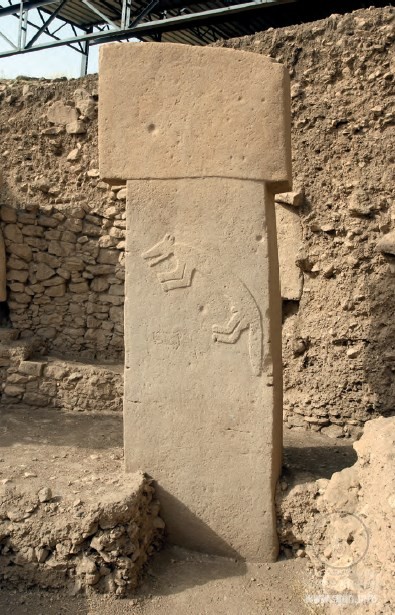 |
Moreover, the Dogon people consider our Solar System to be the placenta of the devil being Ogo and regard the Earth as “a place where Ogo’s navel string connects with his placenta...” It is interesting that Ogo characteristics are very similar to those of Lucifer who has been called “the prince of this world” from time immemorial. In other words, he is exactly the prince of this material world, thus animal principles reign here. Later on the Earth was attended by god Nommo who also arrived from Sirius. He overcame fox Ogo and provided the Dogon people with knowledge in many fields. Therefore, we again see an act of Knowledge transfer to humanity by a superior being, so that humanity could overcome “the beast” or animal nature in themselves. A fox – a clever and artful predatory animal – is exactly an embodiment of the animal nature. Hence, we see human nature is dual, and the ancients were well aware of that. By the way, the Dogon people believe that Nommo will once return.
On the sides of the two central T-shaped orthostats in Circle В we can see a fox image symbolising the animal nature. These pillars are located opposite each other and, as we already know, personify a human being.
|
Circle В, Pillar 9 |
Circle В, Pillar 10 |
||
|
Tau cross |
Versions of Ankh cross depiction |
It should be noted that in Ancient Egypt a human being could be symbolically depicted as a Tau cross. At that, should a circle be added above it an Ankh cross emerges, which is a symbol of a human being who follows the spiritual way. Yet, why were animals depicted on lateral sides of pillars?
|
|
|
|
In the AllatRa book by A. Novykh we read that a human being is highly complex. As we can see in the picture on the left, a human being has a pyramidal energy structure built around the soul as a particle from the world of God. The structure is situated in 6 lower dimensions. Sides of the pyramid are the four so-called human Aspects. Since ancient times the Aspects have been depicted as animals with different characteristics. For example, the Left and Right Aspects were depicted as aggressive wild animals and located on corresponding sides of a human being. Images of such animals were placed on temple gates as a reminder that a visitor was supposed to become purer and leave his or her animal aspirations outside. |
The same thing may be observed in Göbekli Tepe.
|
U-shaped stone before the temple entrance |
Artistic reconstruction |
In order to get into the sacred space of a temple, a visitor first had to pass through a narrow gate with animals on each side, walk along a long corridor which archaeologists call dromos, and then pass through a labyrinth. Such a long way was necessary for one to become purer and tune in to a prayer. Moreover, the way symbolised a difficult and often labyrinth-like tangled journey of a human being towards his or her genuine essence.
The inner space of the temple complex also abounds in images of aggressive animals that are mostly depicted in attacking poses. Some of the animals are carved in stone as whole figures, others are carved on pillars.
|
A wild boar |
A wolf |
A lion |
|
|
Furthermore, at GT site many images and figurines of men with erect phalli (a symbol of life) are found. Archaeologists call such figurines ithyphallic. Besides, there are numerous images as those described by Klaus Schmidt:
|
Similar serpentine motifs were found in many ancient cultures. We have considered this topic in the article The Cucuteni-Trypillian civilization: anthropomorphic plastic art and its sacral meaning.
|
A stone idol with snakes |
A snake image |
In a nutshell, such artefacts evidence that the ancients possessed knowledge of the sexual energy and its important role in certain spiritual practices. It is not without reason that the animal mind system keeps speculating about this subject in order to distract people from the spiritual way and direct human force to totally different channels.
Now, let’s consider another interesting artefact in detail. It is Pillar 18 – one of the two paired central pillars located in Circle D almost opposite the Vulture Stone.
|
Circle D. Pillar 18 and its enlarged fragments |
|
How can we decipher the symbolism of this pillar from the perspective of the Primordial Knowledge given in the AllatRa book?
The stone rectangular base symbolises the material world. However, there are images of waterfowls on it, resembling ducks. Waterfowls are associated with the water element and, just like water itself, in spiritual traditions they symbolise immersion in an altered state of consciousness during spiritual practices. The number of the waterfowls (7) symbolise the dimension from where one starts exploring the spiritual world and where the animal mind has no power.
A T-shaped pillar stands on the base. Judging by the presence of hands, it symbolises a human being. A fox is depicted on the side as a symbol of the animal nature – the dark, yet inalienable part of every human being. On the human figure’s belt there is a fox fell showing that this person controls his or her animal nature. The position of the figure’s palms is also symbolic: they rest on the lower part of the belly right in the spot where the Hara chakran in situated (this chakran is used in a number of spiritual practices). This is an indication that the person controls his or her sexual energy. H-shaped symbols are depicted on the belt in various versions.
|
|
On the front side of the figure, almost in the solar plexus area, there is the ancient AllatRa sign – a crescent with its horns pointing upwards and a circle above it. For better understanding let me refer to several quotes from the AllatRa book:
|
The name of this sign – AllatRa – speaks of the quality of its power. The thing is that at the dawn of mankind, owing to the primordial Knowledge, people knew of the One (the One Who created everything), designating His manifestations with the sound Ra. The generative power of Ra – the divine feminine principle, the Foremother of all things in existence – was initially called Allat. Hence, people initiated into the spiritual Knowledge started calling this original sign AllatRa as a symbol of the creating power of the One Who created everything.
The AllatRa sign works in dimensions above the sixth one, and this puts it in line with those few unique working signs that are available to people in this world... Thus, the AllatRa sign is a truly powerful sign which allows one to save and multiply the powers of Allat in oneself, of the power that comes from God Himself and is directed immediately at creation, that is, at implementation of His plan. That is why in the sacred sense this sign is considered to be the embodiment of the power of God through Allat
The AllatRa sign was also used to describe the one who has come from the Spiritual World (the other, superior world) into this material world, renewing the lost primordial Knowledge.
The last quote suggests that this orthostat embodies one who has come to renew the Knowledge, whereas Pillar 43 located opposite the orthostat indicates the date when such an event took place. Yet, why an H-shaped symbol similar to that on the belt is depicted above the sign? Most probably, this symbol points to the continuity of the Knowledge transfer. To understand the logic, let me cite several quotes from Sensei of Shambala – Book IV by A. Novykh:
Let’s put it so, the word ‘Sakh’ had several meanings in Ancient Egypt. ‘Sakh’ meant ‘enlightenment’. The same word referred to the Orion constellation which they considered to be the king of stars. By the way, they often attached the name of Orion also to Osiris, while his spouse Isis was called Sotis (star Sirius, the closest to the Earth).
For instance, the Orion constellation was called the soul of god Osiris. Sotis, or Sirius in our language, was the soul of goddess Isis, the faithful spouse of Osiris…
… as a matter of fact, the meaning of Allat is universal. Actually it is a word of extraterrestrial origin. It came to us, as I have already said, from Phaeton, to Phaeton from Sirius, and to Sirius it had come from more advanced civilizations.
As it is known, god Osiris was a real person who once also brought the Knowledge to humanity and whom Egyptians associated with Orion. Yet, where was the Knowledge brought to Sirius from, and why was Osiris often called Orion? A hint is contained in another book by A. Novykh – Ezoosmos:
In the tamga of the Shambala Sovereign, there is a similar lotus flower with a pyramid and an eye inside, but in the eye there cased a stone of a much bigger size than that of the stones in Pravi and Navi tamgas put together. It is a symbol of “the all-seeing Eye” signifying Shambala. At that, above the pyramid, on the central petal there located a small eye into which even a more interesting stone is fixed. Its density much exceeds that of diamonds. Its small size, compared to bigger stones, by no means belittle its significance. It’s like the Po particle, and the power encapsulated in it is inexhaustible. This pebble symbolizes the absolute power of God over everything including “the all-seeing Eye”… In the tamga of the Shambala Sovereign, the lotus flower is attached to a round monad on which there are three big stones forming a triangle. They symbolise the Orion constellation from where the little pebble was delivered, and not only… These stones point to the divine triplicity, to the power over life and death. In the mundane world, this sign is also called the Grail Sign… Actually, in the complex of symbols drawn on the monad, including the lotus flower, there are symbols of all world religions as an indication of the fact that everything spiritual in the human world comes out of Shambala… Moreover, on each side of the monad there are sculptural imprints on the Egyptian theme which were made, say, as decorations during the last renovation of the tamga.
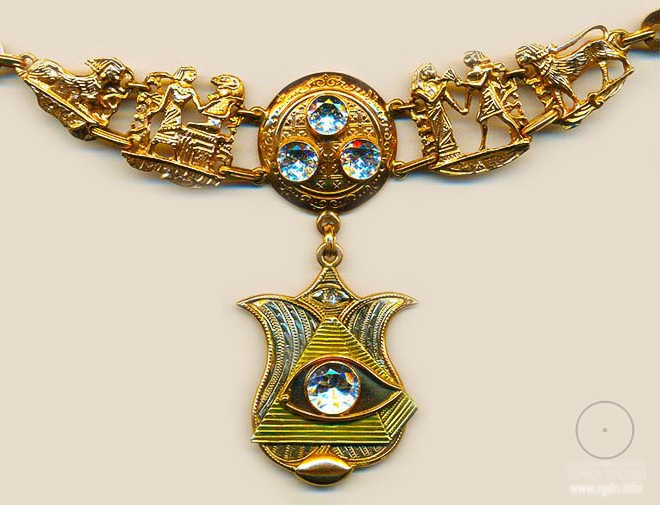
Tamga of the Shambala Sovereign
Hence, the H-shaped symbol on Pillar 18, as the symbol of Orion, points to the place from where the Knowledge was brought. For this very reason it is located above the AllatRa sign that symbolises the one who brought the Knowledge.
In conclusion let’s refer to several astronomy facts about Orion. Should we inquire what the astronomical address of our Solar System is in the Universe, we can discover it is located in the depth of the Milky Way galaxy disc, on the Orion Arm. Furthermore, circa 13,000 years ago Orion was almost at the nearest distance possible to the Earth.
We enjoy looking at beauty.
Yet, not beauty is important, but the essence.
What is beauty? It is momentary, alack.
Only our essence is eternal and imperishable.
(Rūmi)
As we can judge by the above information, GT complex performed multiple functions: it was a cult site, a temple, a sanctuary, an observatory, and a Knowledge depository. The complex existed for several thousands of years, was developed and expanded from time to time. However, due to certain reasons, in the 8th millennium BC it was closed down and simply covered with sand. Probably, a new epoch set in… Thus, GT turned into an unremarkable hill for 10 thousand years. In 1994 GT revival took place, and starting from 1995, despite numerous difficulties, the monument began to be intensively excavated and studied. All that became possible owing to the leadership of Klaus Schmidt – an archaeologist and simply a person who was really fond of his job. Unfortunately, in 2014 a tragic accident cut his life short, and since then the excavations were suspended. As a result, only 5 to 10% of the site have been excavated, and the monument now waits for new researchers and enthusiasts. How many more secrets does the Potbelly Hill conceal under the sand, and what does it keep mum about?
Hopefully, such enthusiasts will emerge, while human greed and stupidity will fail to ruin this marvellous monument of the antiquity. Grievous precedents have already been set: in 2010 one of GT pillars was stolen. Moreover, now this region is one of the most disquieted in the world, since it is very close to the border with Syria where hostilities are permanently taking place.
Well, no matter how you slice it, the earth eventually reveals its secrets to humanity and gladdens persistent searchers with beautiful artefacts that have waited in the earth’s depths for their time for thousands of years. Yet, will humanity be able to guess the initial essence of such artefacts, and how will people use the obtained information? This depends on humanity only! That is why in the beginning of the Afterword I have cited a poem by the great Turkish Sufi poet Jalāl ad-Dīn Muhammad Rūmi. I believe this poem reflects the entire sense of what is said herein.
Completing this extensive material, I would like to repeat Graham Hancock’s words: WE HAVE SO MUCH TO LEARN FROM THE ANCIENTS!!!
P.S. When I was preparing this article, a blank verse impromptu came to my mind:
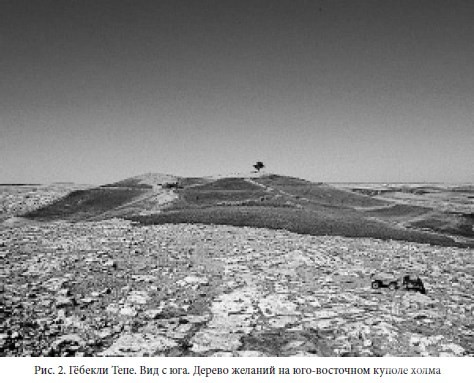 |
Midday, |
Prepared by Sviatoslav Sergeyev (Kiev, Ukraine) jointly with the Point of View analyst team
Major sources:
Klaus Schmidt. Sie bauten die ersten Tempel. Das rätselhafte Heiligtum der Steinzeitjäger
https://tepetelegrams.wordpress.com – News & Notes from the Göbekli Tepe Research Staff
https://arxiv.org/ftp/arxiv/papers/1307/1307.8397.pdf – report by Giulio Magli
http://www.ed.ac.uk/news/2017/ancient-stone-confirms-date-of-comet-strike – the University of Edinburgh announcement of the report by Martin B. Sweatman and Dimitrios Tsikritsis
http://maajournal.com/Issues/2017/Vol17-1/Sweatman%20and%20Tsikritsis%2017%281%29.pdf – report by Martin B. Sweatman and Dimitrios Tsikritsis
http://grahamhancock.com – Graham Hancock’s official website
www.andrewcollins.com – Andrew Collins’s official website
 Göbekli Tepe: what the Potbelly Hill keeps mum about. A history and astronomy research
votes:
354
Göbekli Tepe: what the Potbelly Hill keeps mum about. A history and astronomy research
votes:
354
|

Project Aim










Leave comment